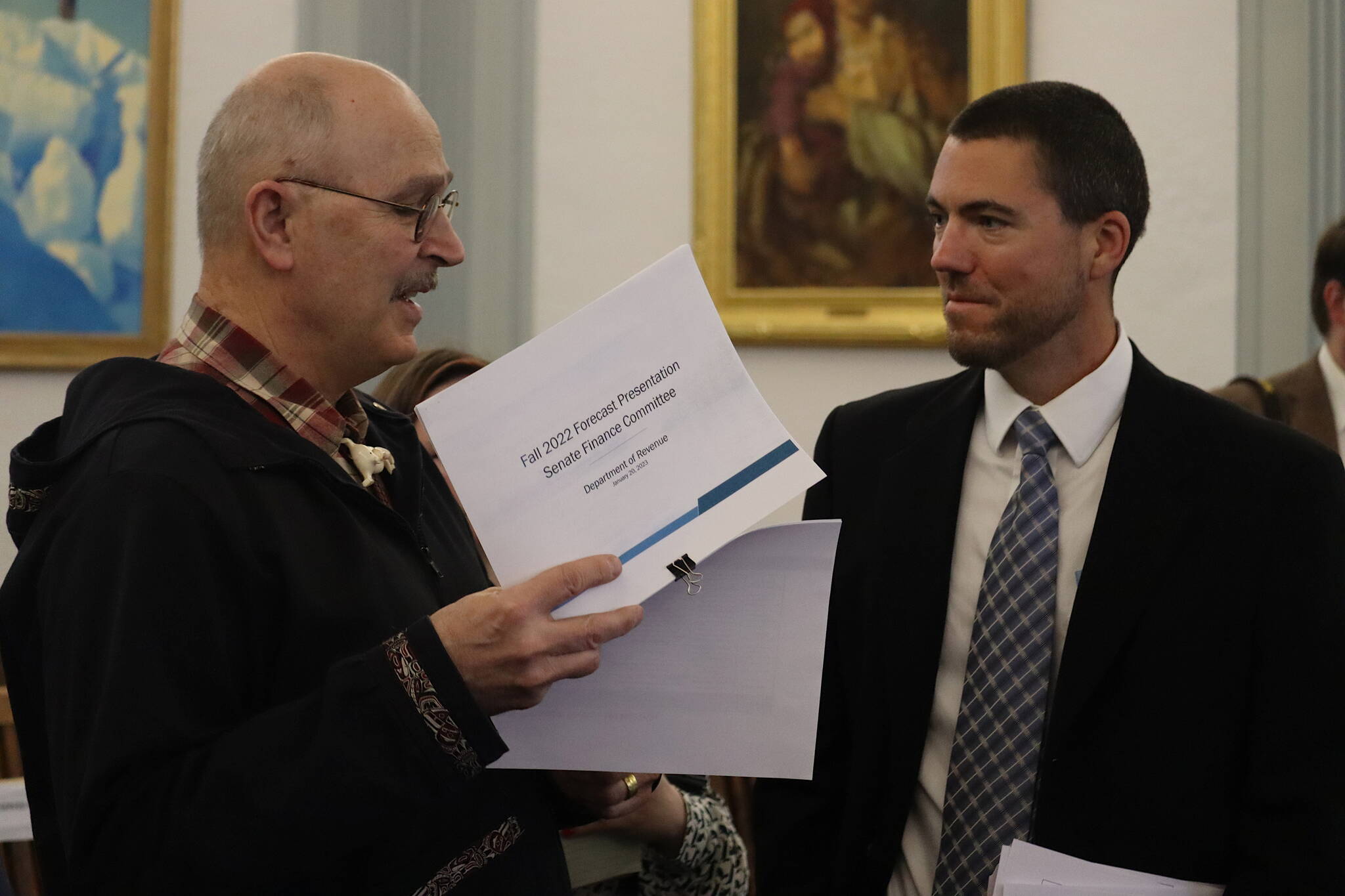The saying is numbers don’t lie, but figures showing relatively stable future oil income for Alaska despite unprecedented global volatility came with an admission by the presenter that they aren’t the absolute truth.
“What we do know is the actual price will be different than what we’re forecasting,” Dan Stickel, economic research chief for the state Department of Revenue, told the state Senate Finance Committee on Friday.
That applies to both the short-term forecast for this year and next, as well as the long-term forecast for the next decade, he explained during the committee’s first overview of the legislative session of the state’s revenue situation.
Of the state’s $15.4 billion in revenue for the current year, 33.5% is from investment earnings, 32% from the federal government and 27.5% from petroleum, according to a chart presented by revenue officials. Fisheries accounted for 0.7%, tourism 0.6% and mining 0.4%.
Senators weren’t thrilled with some aspects of the presentation — both when numbers were specific and when they were vague — while also acknowledging the state budgets they implement based on the forecasts have their own numerical imperfections.
“We do the best we can to estimate, but that’s just what it is — estimations,” said Sen. Bert Stedman, a Sitka Republican who co-chairs the committee, in a comment directed toward members of the general public, explaining why things such as supplemental funding requests are needed during a budget year when things don’t balance as expected.
The presentation, focusing on the fall forecast published last month with some updates made this week, predicts average oil prices of $88.45 a barrel for the current fiscal year ending June 30 and $81 next year. In simple terms, that means the state will essentially break even this year and lawmakers will have far less money to craft a budget than they assumed they had last year.
Republican Gov. Mike Dunleavy, in his proposed budget released at the same time as the revenue forecast, is calling for a spending plan that uses about $250 million of the state’s roughly $2 billion in reserve funds. Sen. Jesse Kiehl, a Juneau Democrat on the Finance Committee, said at a recent town hall that the reserve funds to cover next year’s gap could actually be twice as much as the governor predicts when supplemental and other extra contingency spending is factored in.
Among the major uncertainties revenue officials and lawmakers are facing are the global uncertainties that cast the state’s financial situation into chaos last year, Stickel said.
Oil prices skyrocketed when the war in Ukraine started last February before rapidly retreating after the budget was signed in July, meaning lawmakers’ lavish hopes of “forward funding” education a year ahead of time had to be abandoned. Now with China facing economic turmoil due to a resurgence of COVID-19 and Russia redoubling its fight against Ukraine the official state forecast of a relatively uneventful year for oil prices is anything but certain, Stickel said.
“We are in a period of historically high volatility,” he said while showing a chart with essentially flat-line future oil prices. “We have been since COVID hit. The slide you’re looking at here is the most likely case.”
The long-term forecast through 2030 was about $85 a barrel last spring and $82 in the fall forecast. Stickel said updated research this week shows a likely lower average price of $80 a barrel or lower through 2026, with a slow decline during those years.
Furthermore, the production forecast — the obvious other half of revenue from sales — ranges from about 380,000 to 620,000 barrels per day next year, with the span widening to between 250,000 and 850,000 barrels a day by 2032.
Stedman, noting Stickel and other top revenue department officials will be before the committee again during the coming weeks and months, said he wants a better grasp of the potential short- and-long-term price variability so lawmakers can better plan a budget and general fiscal plan that takes various scenarios into account. He also questioned some of the department’s projected income figures from North Slope production asserting it’s too pessimistic in the wake of Hilcorp Energy’s production strategy after taking over management of the Prudhoe Bay oil field from BP in late 2020.
“What’s not reflected is increases on the North Slope, anomalies that are on the high side,” Stedman said, adding “I think there’s some real positive news in the uptick in production that I’d like to see reflected in our data charts.”
Furthermore, the trend has long-term potential if other fields such as the Willow oil project in the National Petroleum Reserve-Alaska come online, Stedman said.
Stickel said the department has a more guarded assessment of the overall picture.
“There are some fields that are coming in a little bit stronger than expect and there are some that are coming in weaker than expected,” he said.
Such hopes of continuing high revenue from oil come as lawmakers are increasingly being challenged to come up with alternative and stable long-term income for the state due the assumed inevitable decline of oil revenue, along with proposals such as reducing or eliminating tax incentives to oil production companies. Dunleavy, for instance, is proposing a long-term carbon credits plan he claims could eventually earn as much as oil.
• Contact reporter Mark Sabbatini at mark.sabbatini@juneauempire.com

